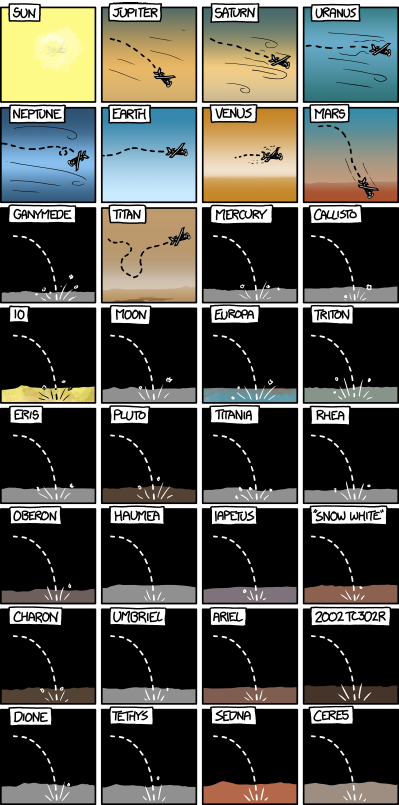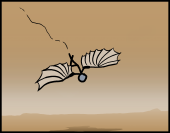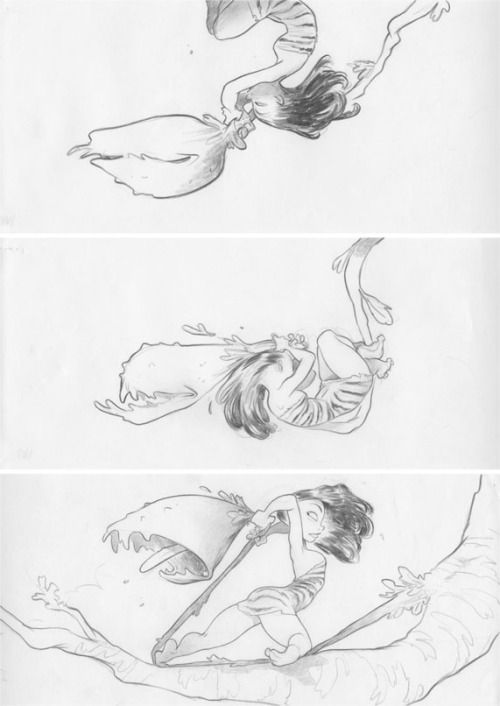


ZONEKINDER are going on a summer tour through Denmark, France and Germany to bring life to some unexpected places. Keep an eye out to see where their tree characters might show up!



ZONEKINDER are going on a summer tour through Denmark, France and Germany to bring life to some unexpected places. Keep an eye out to see where their tree characters might show up!
This utility ring is made from aerospace grade titanium and will make sure you’re prepared in every situation. It has five different tools including a bottle opener, a straight blade, a serrated blade, a saw, and even a comb. Okay, it’s a teeny tiny comb but it does the job (on mustaches maybe). It measures 9mm wide and is custom made to your size for a perfect fit. Just think how handy this little ring could be during the zombie apocalypse.
Product Page ($385 Cool Material)
What would happen if you tried to fly a normal Earth airplane above different Solar System bodies?
—Glen Chiacchieri
Here’s our aircraft:

The Cessna 172 Skyhawk, probably the most common plane in the world.
Here’s our pilot:

Here’s what happens when the aircraft is launched above the surface of the 32 largest Solar System bodies:

In most cases, there’s no atmosphere, and the plane falls straight to the ground. (If it’s dropped from one kilometer, in a few cases, the crash will be slow enough that the pilot may survive—although the life-support equipment probably won’t.)
There are nine Solar System bodies with atmospheres thick enough to matter: Earth—obviously—Mars, Venus, the four gas giants, Saturn’s moon Titan, and the Sun. Let’s take a closer look at what would happen to a plane on each one.
The Sun: This works about as well as you'd imagine. If the plane is released close enough to the Sun to feel its atmosphere at all, it's vaporized in less than a second.
Mars: To see what happens to aircraft on Mars, we turn to X-Plane.
X-Plane is the most advanced flight simulator in the world. The product of 20 years of obsessive labor by a hardcore aeronautics enthusiast who uses capslock a lot when talking about planes, it actually simulates the flow of air over every piece of an aircraft’s body as it flies. This makes it a valuable research tool, since it can accurately simulate entirely new aircraft designs—and new environments.
In particular, if you change the X-Plane config file to reduce gravity, thin the atmosphere, and shrink the radius of the planet it can simulate flight on Mars. (Note: Thank you to Tom J and the folks in the X-Plane community for their help with aerodynamic calculations in different atmospheres.)
X-Plane tells us that flight on Mars is difficult, but not impossible. NASA knows this, and has considered surveying Mars by airplane. The tricky thing is that with so little atmosphere, to get any lift, you have to go fast. You need to approach Mach 1 just to get off the ground, and once you get moving, you have so much inertia that it’s hard to change course—if you turn, your plane rotates, but keeps moving in the original direction. The X-Plane author compared piloting Martian aircraft to flying a supersonic ocean liner.
Our Cessna 172 isn’t up to the challenge. Launched from 1 km, it doesn’t build up enough speed to pull out of a dive, and plows into the Martian terrain at over 60 m/s (135 mph). If dropped from four or five kilometers, it could gain enough speed to pull up into a glide—at over half the speed of sound. The landing would not be survivable.
Venus: Unfortunately, X-Plane is not capable of simulating the hellish environment near the surface of Venus. But physics calculations give us an idea of what flight there would be like. The upshot is: Your plane would fly pretty well, except it would be on fire the whole time, and then it would stop flying, and then stop being a plane.
The atmosphere on Venus is over 60 times denser than Earth’s, which is thick enough that a Cessna moving at running speed would rise into the air. Unfortunately, the air it’s rising into is hot enough to melt lead. The paint would start melting off in seconds, the plane’s components would fail rapidly, and the plane would glide gently into the ground as it came apart under the heat stress.
A much better bet would be to fly above the clouds. While Venus’s surface is awful, its upper atmosphere is surprisingly Earthlike. 55 kilometers up, a human could survive with an oxygen mask and a protective wetsuit; the air is room temperature and the pressure is similar to that on Earth mountains. You need the wetsuit, though, to protect you from the sulfuric acid. (I’m not selling this well, am I?)
The acid's no fun, but it turns out the area right above the clouds is a great environment for an airplane, as long as it has no exposed metal to be corroded away by the sulfuric acid. And is capable of flight in constant Category-5-hurricane-level winds, which are another thing I forgot to mention earlier.
Venus is a terrible place.
Jupiter: Our Cessna can’t fly on Jupiter; the gravity is just too strong. The power needed to maintain level flight is three times greater than that on Earth. Starting from a friendly sea-level pressure, we’d accelerate through the tumbling winds into a 275 m/s (600 mph) downward glide deeper and deeper through the layers of ammonia ice and water ice until we and the aircraft were crushed. There's no surface to hit; Jupiter transitions smoothly from gas to solid as you sink deeper and deeper.
Saturn: The picture here is a bit friendlier than on Jupiter. The weaker gravity—close to Earth’s, actually—and slightly denser (but still thin) atmosphere mean that we’d be able to struggle along a bit further before we gave in to either the cold or high winds and descended to the same fate as on Jupiter.
Uranus: Uranus is a strange, uniform bluish orb. There are high winds and it’s bitterly cold. It’s the friendliest of the gas giants to our Cessna, and you could probably fly for a little while. But given that it seems to be an almost completely featureless planet, why would you want to?
Neptune: If you’re going to fly around one of the ice giants, Neptune (Motto: “The Slightly Bluer One”) is probably a better choice than Uranus. It at least has some clouds to look at before you freeze to death or break apart from the turbulence.
Titan: We’ve saved the best for last. When it comes to flying, Titan might be better than Earth. Its atmosphere is thick but its gravity is light, giving it a surface pressure only 50% higher than Earth’s with air four times as dense. Its gravity—lower than that of the Moon—means that flying is easy. Our Cessna could get into the air under pedal power.
In fact, humans on Titan could fly by muscle power. A human in a hang glider could comfortably take off and cruise around powered by oversized swim-flipper boots—or even take off by flapping artificial wings. The power requirements are minimal—it would probably take no more effort than walking.
The downside (there’s always a downside) is the cold. It’s 72 kelvin on Titan, which is about the temperature of liquid nitrogen. Judging from some numbers on heating requirements for light aircraft, I estimate that the cabin of a Cessna on Titan would probably cool by about two degrees per minute.
The batteries would help to keep themselves warm for a little while, but eventually the craft would run out of heat and crash. The Huygens probe, which descended with batteries nearly drained (taking fascinating pictures as it fell), succumbed to the cold after only a few hours on the surface. It had enough time to send back a single photo after landing—the only one we have from the surface of a body beyond Mars.
If humans put on artificial wings to fly, we might become Titan versions of the Icarus story—our wings could freeze, fall apart, and send us tumbling to our deaths.

But I've never seen the Icarus story as a lesson about the limitations of humans. I see it as a lesson about the limitations of wax as an adhesive. The cold of Titan is just an engineering problem. With the right refitting, and the right heat sources, a Cessna 172 could fly on Titan—and so could we.
Los guiones de cine se empezaron a redactar en la era de las máquinas de escribir, y siempre se han utilizado como producto final tal cual salían de la máquina —sin edición posterior.
Con el tiempo las herramientas cambiaron. Llegaron los ordenadores, las impresoras y los archivos PDF, pero los guiones han mantenido el mismo aspecto que cuando salían de máquinas de escribir. En concreto los guiones están escritos con la tipografía Courier a tamaño de 12 puntos.
Su origen está en la máquina de escribir más popular de IBM, la Selectric II, y pronto se convirtió en la tipografía por defecto en Hollywood.
El hecho de utilizar siempre la misma tipografía al mismo tamaño [ambas características de hoy heredadas de la máquina de escribir] tiene algunas ventajas.
Por ejemplo, una página de guión suele equivaler a un minuto de película en la pantalla. Más importante aún, los productores pueden tener la certeza de que un borrador que ocupe 119 páginas será realmente más corto [y supondrá menos metraje] que un borrador de 140 páginas. A diferencia de como se hace con los trabajos del colegio, los guionistas no juegan con el tipo de letra para manipular el número de páginas de sus escritos.
Un repaso a la historia de la tipografía Courier con motivo del nacimiento de la Courier Prime, que respeta toda la herencia de la Courier original pero está optimizada para su visualización a resoluciones más altas que la original.
La tipografía Courier Prime está disponible para Mac y Windows de forma gratuita.
Vía Daring Fireball.

I realize they mean two different things. I’m just saying one of those things you probably don’t need to share. Because come on, who wants to know where your child was born? Now conceieved on the other hand… -Will
TweetAs we didn’t have much anamorphoses lately, let me show you some of the latest works by Jonty Hurwitz. This whole trend started with #Salvador Dali, where back in the old days, artists had to make all of the necessary calculations on their own, for the anamorphic image to reflect properly. Sometimes they even painted on the fly, observing the reflection inside the cylinder and adjusting their sketch accordingly. Nowadays it’s much easier to get the anamorphic version of any picture – there are computer programs that do this automatically. However, Jonty doesn’t work with images, but creates 3d anamorphic sculptures instead. Check the gallery below and prepare to be amazed!
You may remember Dali worked with anamorphic images that were recreated on a glossy surface of a metal tube. As for Salvador Dali he did pictures and all mathematics by himself, as for modern figurative sculptor Jonty Hurwitz, computing is a first thing before he begins to create complex anamorphic sculptures. That’s clear the process cannot rely only on hands and an eye.
Los mapas de los videojuegos siempre son una pieza de arte del mismo que vale la pena destacar, bueno, aunque solo en unos casos, el primer mapa que recuerdo es el de Super Mario Bros 3, y en ese entonces me parecía gigante, ahora los mapas son todavía más artísticos, con mejor calidad y sobre todo, muchísimo más grandes.
Publicado el 31 de marzo de 2009
Publicado el 9 de agosto de 2010
Publicado el 29 de marzo de 2011
Two words make it about a thousand times more likely that I’ll add a given piece of clothing to my wardrobe: fleece sweatshirt. It’s a description that screams comfort, and Rarity’s Boutique is offering fleece hoodies for the first time in Portal styles.
The shop has two options available in unisex or more fitted women’s sizes – you can choose between a turret or Companion Cube. Both designs are wonderful and instantly recognizable. Each hoodie is made to order and takes about 3-4 weeks to turnaround.
See more images of the hooded sweatshirts after the break.
Product Page ($140)
Sherlock isn’t technically a superhero, but he solves at least as many crimes and is just as good at catching bad guys. This shirt gives him his own comic in the style of an old Batman comic cover. Quick, to the Sherlockmobile!
Product Page ($24.54 via shirtoid)
This looks so great! An animated-short anthology with films by Charles Huettner, Dave Prosser, Sean Buckelew, Louise Bagnall, Jake Armstrong & Erin Kilkenny, Eamonn O’Neil, Daniella Orsini & Joe Orton, Scott Benson, Alex Grigg, Conor Finnegan, Christen Bach, and more. These folks are doing it up right, too - when they get it all assembled this spring, you’ll be able to get a great-sounds pile of goodies along with the films, and you can follow the project on twitter and tumblr too.
NOTE: The trailer is ever-so-slightly NSFW, if your work gets upset about split-second flashes of animated non-aroused male nudity.
By the way, here’s some advice from anecdotal evidence and personal experience: make stuff you want to make - personal projects give you room to explore, and they lead to more interesting client work. Well done, Late Night Work Club animators!
Hey everyone, the trailer for our independent animation anthology ‘Late Night Work Club project #1’ just hit the internet! Take a look and spread it around. Check out the website for more info.
Scott Benson has done a great job organizing it all and I couldn’t be more pleased to be included with so many great animators.


Chris Sanders (Co-Director of Lilo & Stitch, How To Train Your Dragon, The Croods) shares some unused storyboards from his latest film The Croods.
I think I’d rather just watch 90 mins of Sanders drawing storyboards than watch the finished movie; these are beautiful!
What if I took a swim in a typical spent nuclear fuel pool? Would I need to dive to actually experience a fatal amount of radiation? How long could I stay safely at the surface?
—Jonathan Bastien-Filiatrault
Assuming you’re a reasonably good swimmer, you could probably survive treading water anywhere from 10 to 40 hours. At that point, you would black out from fatigue and drown. This is also true for a pool without nuclear fuel in the bottom.
Spent fuel from nuclear reactors is highly radioactive. Water is good for both radiation shielding and cooling, so fuel is stored at the bottom of pools for a couple decades until it’s inert enough to be moved into dry casks. We haven’t really agreed on where to put those dry casks yet. One of these days we should probably figure that out.
Here’s the geometry of a typical fuel storage pool:

The heat wouldn't be a big problem. The water temperature in a fuel pool can in theory go as high as 50°C, but in practice they're generally between 25°C and 35°C—warmer than most pools but cooler than a hot tub.
For the kinds of radiation coming off spent nuclear fuel, every 7 centimeters of water cuts the amount of radiation in half.
The most highly radioactive fuel rods are those recently removed from a reactor. Based on the activity levels provided by Ontario Hydro in this report, this would be the region of danger for fresh fuel rods:

Swimming to the bottom, touching your elbows to a fresh fuel canister, and immediately swimming back up would probably be enough to kill you.
Yet outside the outer boundary, you could swim around as long as you wanted—the dose from the core would be less than the normal background dose you get walking around. In fact, as long as you were underwater, you would be shielded from most of that normal background dose. You may actually receive a lower dose of radiation treading water in a spent fuel pool than walking around on the street.

That’s if everything goes as planned. If there’s corrosion in the spent fuel rod casings, there may be some fission products in the water. They do a pretty good job of keeping the water clean, and it wouldn’t hurt you to swim in it, but it’s radioactive enough that it wouldn’t be legal to sell it as bottled water. (Which is too bad—it’d make a hell of an energy drink).
We know spent fuel pools can be safe to swim in because they’re routinely serviced by human divers.
However, these divers have to be careful.
On August 31st, 2010, a diver was servicing the spent fuel pool at the Leibstadt nuclear reactor in Switzerland. He spotted an unidentified length of tubing on the bottom of the pool and radioed his supervisor to ask what to do. He was told to put it in his tool basket, which he did. Due to bubble noise in the pool, he didn’t hear his radiation alarm.
When the tool basket was lifted from the water, the room’s radiation alarms went off. The basket was dropped back in the water and the diver left the pool. The diver’s dosimeter badges showed that he’d received a higher-than-normal whole-body dose, and the dose in his right hand was extremely high.
The object turned out to be protective tubing from a radiation monitor in the reactor core, made highly radioactive by neutron flux. It had been accidentally sheared off while a capsule was being closed in 2006. It sank to a remote corner of the pool floor, where it sat unnoticed for four years.
The tubing was so radioactive that if he’d tucked it into a tool belt or shoulder bag, where it sat close to his body, he could’ve been killed. As it was, the water protected him, and only his hand—a body part more resistant to radiation than the delicate internal organs—received a heavy dose.

So, as far as swimming safety goes, the bottom line is that you’d probably be ok, as long as you didn’t dive to the bottom or pick up anything strange.
But just to be sure, I got in touch with a friend of mine who works at a research reactor, and asked him what he thought would happen to you if you tried to swim in their radiation containment pool.
“In our reactor?” He thought about it for a moment. “You’d die pretty quickly, before reaching the water, from gunshot wounds.”
- Sandy South: Taking away a 12-year-old boy’s favorite figurine. Who would do such a mean thing?! I’ll tell you!!
- Qoo: A little sister who’s mad at her brother?
- Sandy South: No, silly…
- Sandy South: … the Recording Industry Association of America!
- Sandy South: Sure, the course of action is rather reminiscent of Big Oil, but even they have standards.
Legend of Zelda‘s Link has been turned in a fox with little animal masks floating around him in this image by artist Teagan White. It was done for a fundraiser for the Press Paws charity art show which raised funds for the “What’s Up Dog” animal rescue service in Los Angeles. It’s available as a t-shirt, hoodie or print.
Product Page ($18 via it8bit)
TARDIS dresses have been popping up all over the convention scene in the past few years, and it’s always neat to see the different takes on the blue police box. This lady, believed to be Sasha Trabane, has a TARDIS dress that can be opened to feature the interior. The Doctor would love her.
Photographed by Jere7my.
See the TARDIS dress with the door closed after the break.
(via Boing Boing)

If Indiana Mouse makes it past the trap, he’ll still have to contend with the angry lady with a broom.
Grab this tee for $10 today only!
Product Page ($10)